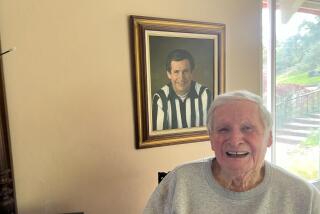NFL Must Firm Grip on Steroids
- Share via
When it comes to steroids, the best metaphors come from within the sports: Baseball gets all the hits, and the NFL gets a pass.
During congressional hearings in April, the politicians heaped praise on the NFL’s steroid testing policy. The NFL was complimented, in part, because it appeared to handle the matter so much more capably than baseball and its commissioner, bumbling Bud Selig, did during their turn in March. As if that were enough.
“I think the way Rafael Palmeiro handled it was better than a couple of the guys,” said anti-steroid crusader Don Hooton, who also testified during baseball’s day on Capitol Hill. “And look what happened.”
Palmeiro went from being the innocent guy -- Mr. Never. Ever. Period. -- to Sir Steroids, the public face of baseball’s shame.
What Palmeiro taught us is that we have a right to be skeptical. In fact, we’re negligent if we aren’t skeptical. Just because someone doesn’t fit our concept of steroid user doesn’t mean he isn’t juicing.
It used to be that our image of a steroid user was one of three things: a hairy East German female swimmer, a bodybuilder with massive pecs or a swollen NFL lineman. They’ve all been replaced by a 40-year-old guy with a mustache.
And now, because the NFL has had a steroid policy in place since 1987 and says it has cleaned up its sport, we’re supposed to believe steroid use doesn’t exist in football anymore?
“They’ve got a testing program,” Hooton said. “Well, so what? The question is whether it’s effective or not.
“Look at the size of some of these players and their performance and symptoms. Trust your eyes, guys. Trust your instincts.”
The program didn’t catch three members of the Super Bowl XXXVIII Carolina Panther team who received steroids through a doctor’s illegal prescriptions, according to a “60 Minutes” report. The program, like baseball’s, doesn’t test for human growth hormone or any of the newest cheating tactics.
“They [the NFL] can pat themselves on the back at being at the head of the class, but they’ve got to keep pace with a rapidly changing approach, so the fans are left with little or no doubt in their minds,” said Gary Wadler, a New York University medical professor who also testified in the congressional hearings. “I strongly do think they were way ahead of everyone in pro sports in this country. But here we are at a crossroads at professional sports in America, which has evoked enormous interest in the Congress, enormous interest from the public. Where do we go from here?”
Wadler, who serves on the World Anti-Doping Agency, would like to see the NFL -- and other American pro sports leagues -- head toward the testing standards and punishments adopted by WADA and allow an independent agency to administer blood tests and impose sanctions as it does for the Olympics, where a first-time violator receives a two-year ban. Currently the NFL handles the tests (urine samples only) and the penalties (beginning with a four-game suspension for the first violation).
NFL Commissioner Paul Tagliabue told the panel that the penalties were appropriate and that there isn’t a reliable test for human growth hormone, but if one were developed he would consider adding it. (An NFL spokesman declined to comment Wednesday.)
If the system is good, what’s the harm in adopting one that’s better and stronger?
“I don’t want to sound like I’m coming down on the NFL,” Wadler said. “I just think that’s the path they need to take.
“I think the average fan has to feel, ‘Is this thing transparent? Do I know what went on here or not? Do I know if they’re playing fair or not? How do I have confidence in that judgment?’ That is where I think they’ve been hurting.”
For Hooton, the issue is deeply personal. His 17-year-old son, an aspiring baseball player, committed suicide two years ago. Hooton is convinced his son Taylor became depressed because of mood swings caused by steroids.
He formed the Taylor Hooton Foundation to raise awareness about the dangers of steroid abuse among teenagers. He’ll speak anytime, anywhere, about the widespread problem, which could afflict as many as 1 million high school students.
“My battle is not with the leagues or with the players,” Hooton said. “Mine’s with the kids. We started off sending the message from the professional leagues that this stuff is OK. We now need to send the message from the professional ranks that this stuff is not acceptable.”
For too long there has been a willingness by the media and the public to ooh and ahh at the hitters knocking baseballs out of the park and the impossibly large and agile linemen bashing each other’s brains in without questioning how they got that big. Some even felt that if the players were cheating, they were only harming themselves, so what was the problem?
Ask Hooton.
“When you’ve got 15- and 16-year-old kids, there’s absolutely zero, none, nada deterrent for these kids to do steroids,” he said. “The parents don’t know what to look for, the coaches claim not to know what to look for. We’re leaving it to a 15-year-old’s conscience.
“I’m not going to be happy until we have a real education program in the schools, backed up by a real testing program and real consequences when these kids get caught.”
How can the NFL be happy with anything less than a standard-setting policy for its players?
How can any of us?
J.A. Adande can be reached at [email protected]. To read previous columns by Adande, go to latimes.com/adande.
More to Read
Go beyond the scoreboard
Get the latest on L.A.'s teams in the daily Sports Report newsletter.
You may occasionally receive promotional content from the Los Angeles Times.










